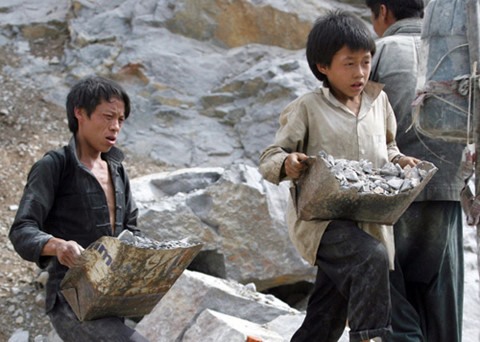 Society
Society

It’s time for Việt Nam to improve and complete its legal framework of child labour, especially regulations on minor employees working in informal sector, experts recommended.
 |
| Children help their parents at a stone mine in Đồng Văn District in the northern mountainous province of Hà Giang. Experts believe that it’s time for Việt Nam to complete a legal framework on child labour. — Photo thanhnien.vn |
HÀ NỘI — Việt Nam needed to improve its legal framework on child labour, especially regulations on minors working in informal sectors, experts recommended.
Minoru Ogasawara, chief advisor of the project ‘Technical Support for Enhancing the National Capacity to Prevent and Reduce Child Labour in Việt Nam’ (ENHANCE), said at a workshop early this week in the northern province of Quảng Ninh that Việt Nam was integrating into the world economy through new generation free trade agreements like the Comprehensive and Progressive Agreement for Trans-Pacific Partnership (CPTPP) and the EU-Việt Nam Free Trade Agreement.
“It’s very important to eliminate or reduce child labour in the supply chain of products that Việt Nam makes for export,” he said.
He said the majority of Việt Nam’s child workers were in informal sectors but the country’s Labour Code did not have regulations addressing these areas.
“The legal framework is not strict enough to protect child workers in informal sectors,” he said.
In Việt Nam, the national survey of child labour in 2012 – the first one of its kind in the country - showed that there were about 1.75 million child labourers nationwide, making up 9.6 per cent of children aged between five and 17.
The number of child labourers is estimated at 1.7 million, with 34 per cent working over 42 hours per week.
In chapter XI of Việt Nam’s Labour Code dated 2012, there are separate provisions for minor employees- who are defined as employees under 18 years of age.
Employment of minors is prohibited in heavy, toxic and dangerous jobs or in workplaces or jobs which may adversely affect their personalities, as determined in a list issued by the Ministry of Labour, Invalids and Social Affairs in co-ordination with the Ministry of Health.
The working time for minors aged from full 15 to 18 years must not exceed 8 hours per day or 40 hours per week. The working time for employees aged under 15 years must not exceed 4 hours per day or 20 hours per week and employers may not employ minors to work overtime or at night.
According to International Labour Organisation, Việt Nam had laid the foundation for effective and sustainable action against child labour.
Việt Nam was the first country in Asia and second in the world to ratify the United Nations’ International Convention on the Rights of the Child.
In November 2000, the Government of Việt Nam ratified the Worst Forms of Child Labour Convention, 1999 (No.182), and in 2003 the Government ratified the Minimum Age Convention, 1973 (No.138).
Ratifications signalled to the international community Việt Nam’s commitment and determination to urgently undertake time-bound measures for the elimination of the worst forms of child labour in the country.
In 2016, the Government launched a programme on the prevention and control of child labour from 2016 to 2020.
However, Hà Nội-based Leadco Legal Counsel, after reviewing and analyzing the legal framework of child labour in Việt Nam, found shortcomings.
The shortcomings were represented at a workshop in Quảng Ninh together with recommendations such as the inconsistency of ages mentioned in definitions of child, juvenile and minor employees, the need to develop legal mechanisms to protect youngsters as well as regulations on child labour in informal sectors.
Hà Đình Bốn, head of the Legal Affairs Department under Ministry of Labour, Invalids and Social Affairs, the ministry planned to submit to the Government a draft of the revised Labour Code next month and submit it to the National Assembly in May for discussion.
The International Labour Organisation estimates there are about 152 million child labourers in the world at present. Working at an early age causes serious consequences, including affecting children’s physical and mental development and preventing their access to suitable education. It also harms socio-economic development, especially the quality of future human resources. — VNS




